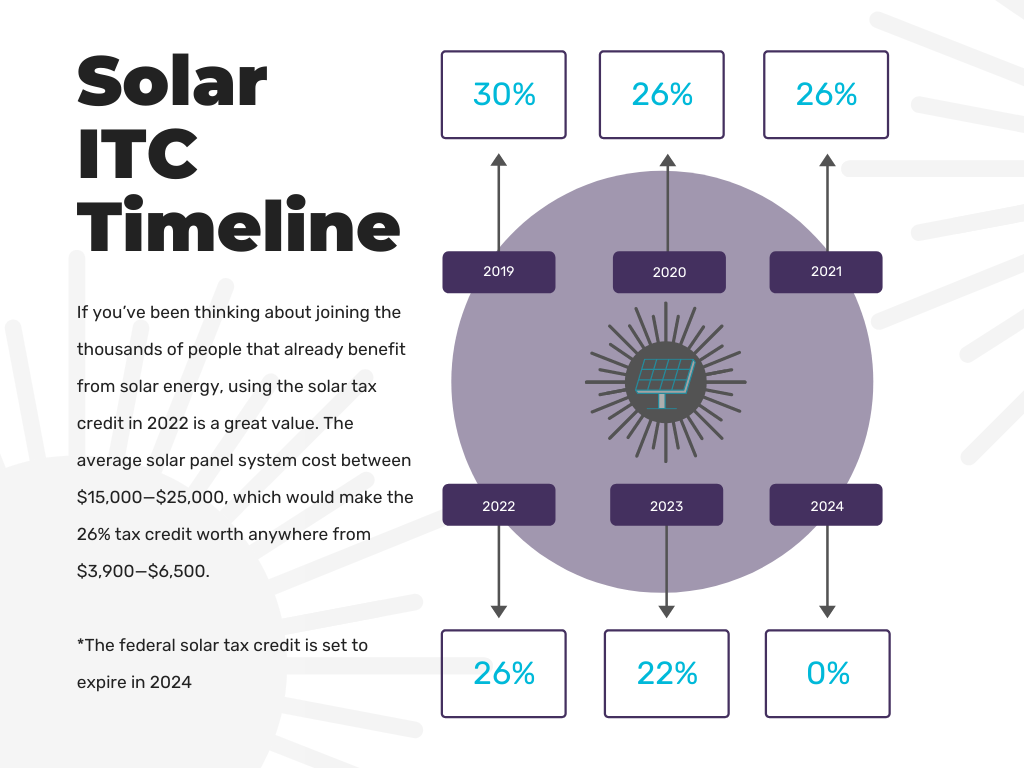
Guest post by: Caitlin Ritchie
What is the Solar Investment Tax Credit?
In 2022, the solar investment tax credit, or ITC, offers a federal tax credit of 26% when you install solar panels on your property. The ITC has many names. When doing your research, you may see mentions of the federal solar tax credit, IRS solar tax credit, solar tax credit, solar ITC, or the investment tax credit. These terms are all referring to the same thing.
Keep reading to find out how the solar tax credit can help you save on your 2022 taxes, what you need to qualify, and how to apply.
Solar Investment Tax Credit Extension in 2022
The ITC was created in 2005 and originally offered a hefty 30% tax credit benefit. In the almost two decade history of the solar tax credit, the credit ratio has been lowered by just 4%.
In relation, the price of installing residential solar panels has steadily declined since the launch of the tax credit, with some reports estimating a reduction in costs by up to 90% in the past decade. So, the value of the solar tax credit in 2022 is arguably even greater than in past years. But the federal tax credit for solar likely won’t be around forever.

Qualifying for the Solar Tax Credit
Many types of homes and apartments qualify for the solar tax credit, including single-family homes, mobile and manufactured homes, apartments and condominiums. Other less-traditional structures, such as houseboats, and cooperative apartments can qualify for the IRS solar tax credit as well.
You can even claim the solar ITC for rental properties you own, as long as you live there for a portion of the year. In this case, the percentage you can claim will depend on the amount of time you reside in your rental property each year. For example, if you live at your rental property for half of the year, and rent it out the other half of the year, you will be allowed to claim 50% of the IRS tax credit.
However, solar consumers who lease their system or enter into a solar power purchase agreement (PPA), are not eligible for the ITC. The federal tax credit for solar is only available if you purchase your solar energy system. If you do not own your solar setup, then the company that does own it is able to claim the solar ITC.
Solar Tax Credit Requirements
- You installed, or will install, a solar panel system between January 1, 2006 and December 31, 2023.
- The solar system is installed on your primary or secondary place of residence.
- You own the solar system and did not lease it or sign a power purchase agreement.
- You invested in a portion of a community solar project and the energy it generates is credited against and does not exceed your home’s electricity usage.
- The solar system is new or is installed for the first time. You do not qualify for the ITC if you bought a home that already has a solar system installed, for example.
Although solar panels are top of mind for most people when it comes to solar energy, the solar ITC covers several types of energy-saving hardware, as well as some labor costs. So, supplementary solar equipment, such as tangential solar roof products, and solar power storage, such as batteries, can also help you reach the maximum 26% federal solar deduction in 2022.
Applying for the Solar Tax Credit
Filing for the solar tax credit in 2022 isn’t too difficult. You will have to fill out and return IRS form 5695. The IRS also provides a printable worksheet with instructions to calculate your expenses and limitations to aid in filling out form 5695. Here’s everything you need:
If you’re out of practice or new to filling out tax forms, worry not. Just remember to keep all receipts. There are also YouTube videos that offer instructions on filling out form 5695. And online tax software, such as Turbotax, will have this form available as well.
There is no extra cost to apply for the solar tax credit (other than the ordinary costs you might incur from getting your taxes done and mailing in forms). Once you’ve sent in your taxes, you should hear back about the result of your IRS solar tax credit in the standard time it takes to receive your federal tax return.
Let’s zoom out for a moment and look at the big picture to get a better idea of how the solar tax credit can help you. Even after receiving your federal tax credit for your new solar panel system, savings will continue to roll in over the long term. Residual savings should add up pretty quickly thanks to the low electricity rates solar owners enjoy. By going green and using the renewable energy of the sun, green electricity rates will keep your monthly electricity bill lower for years to come.
How to claim your IRS Solar Tax Credit
Now that you know how you can benefit from the federal solar tax credit, it is important to understand how you will be receiving your rebate from the IRS.
The IRS offers this refund as a tax credit, which means you will not receive a check for the money you spent. You will, however, receive your savings in the form of a credit on your taxes. So, hypothetically, if you were to file your taxes and ended up owing $4,000 in federal taxes, but you qualified for $3,900 in tax credits due to the solar tax credit, then you would only have to pay the difference of $100 in federal taxes.
Some solar businesses, such as Tesla, are making it even easier to claim your IRS solar tax credit by bundling solar purchases — such as solar panels and batteries. Check to see if your local solar provider offers bundling as an option to make it easier to keep track of your expenses and file for your ITC.
However, remember you will not receive any credits or refunds if you do not owe federal taxes.
You also cannot apply the federal tax credit to state taxes. If you owe federal taxes, but in a lesser amount than your credit, you will only receive a credit up to the amount you owe. Fortunately, the solar ITC can carry over to the next tax year. And, if you previously met the criteria for the solar ITC but forgot to claim it, you can file an amended tax return for last year to get your solar tax credit.
Solar Tax Credit carryover in 2022
If you are interested in claiming the solar ITC, you will need to do so for the same tax year that your home solar system is installed. This means that if you purchased solar panels at the end of 2021 and the installation isn’t complete until January 2022, you will claim the solar tax credit on your 2022 tax return.
So, what if the value of the solar tax credit is more than you owe in income taxes? While you can’t use the tax credit to receive money back from the IRS, the solar tax credit rollover lets you roll the tax credit back one year and carry the solar ITC forward for up to 20 years. So, if you didn’t owe federal taxes last year, you can still claim the solar tax credit on this year’s tax return. And if the solar ITC credits you more than you owe in federal taxes, you will receive the difference in the next tax year until the credit is fully claimed.
For example, if the solar ITC credits you $3,000 when you owe $2,500 in taxes, that extra $500 from the solar tax credit would roll over into the next tax year. That means you wouldn’t have to pay anything in the current tax year, and you will receive a $500 credit on next year’s taxes as well.
Solar Tax Credit Cost Savings
The solar tax credit has not only helped consumers to save on the cost of solar panels, it has also fueled the growth of the renewable energy market. According to the Solar Energy Industries Association (SEIA), “since the ITC was enacted in 2006, the U.S. solar industry has grown by more than 10,000%.” By taking advantage of the 2022 solar tax credit this year, you can join the over half a million homes and businesses that have taken the step towards energy independence, encouraged job creation in the solar market, and saved on their energy bills.
The solar ITC can make installing solar panels a strategic investment, but it won’t mean getting your solar energy system entirely free. You will still have either upfront or monthly payments, depending on if you finance your system, purchase your system upfront, or lease your solar panels.
If you’ve been thinking about joining the thousands of people that already benefit from solar energy, using the solar tax credit in 2022 is a great way to lower the cost of a solar system. The average solar panel system costs between $15,000—$25,000, which would make the 26% tax credit worth anywhere from $3,900—$6,500.
The ITC is expected to lower to 22% in 2023 and expire in 2024. The good news is that if you start now, you still have ample time to do your solar research without feeling like you have to make an impulse buy. Make this year the one where you benefit from this exclusive IRS tax credit by getting solar for your home.
Remember, this is a federal incentive for solar energy systems, which means you can claim it no matter which state you live in. Check to determine whether your state offers additional deductions for solar builds to compound your savings even more.



